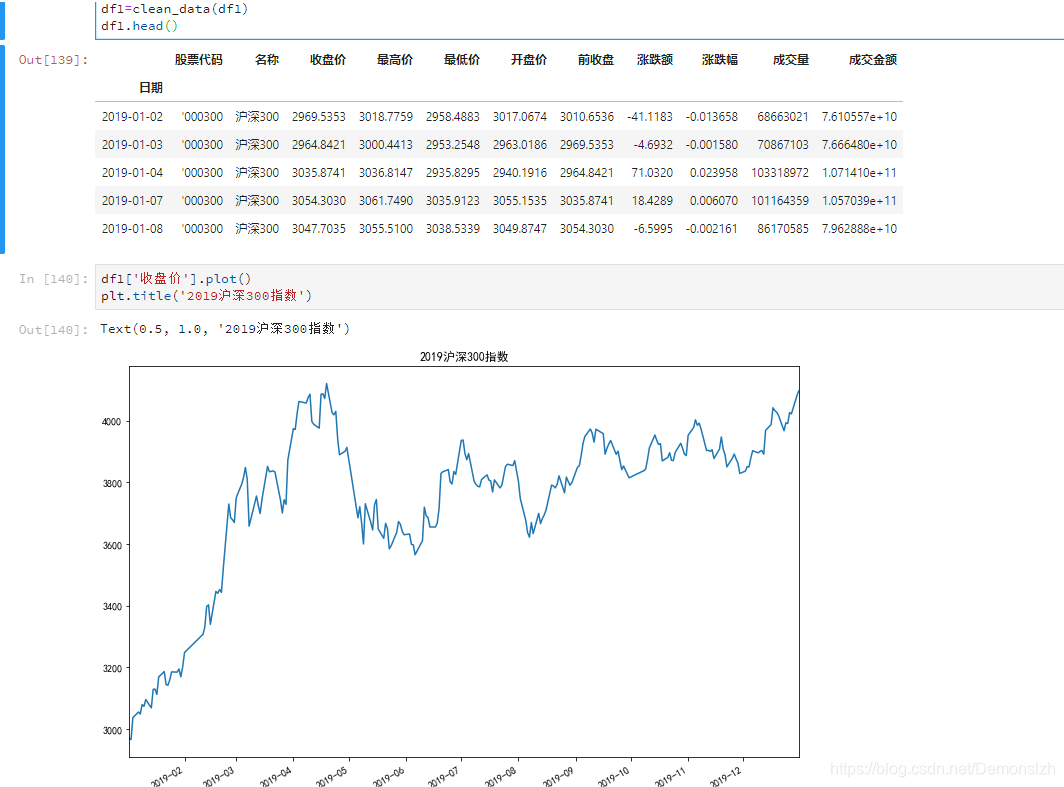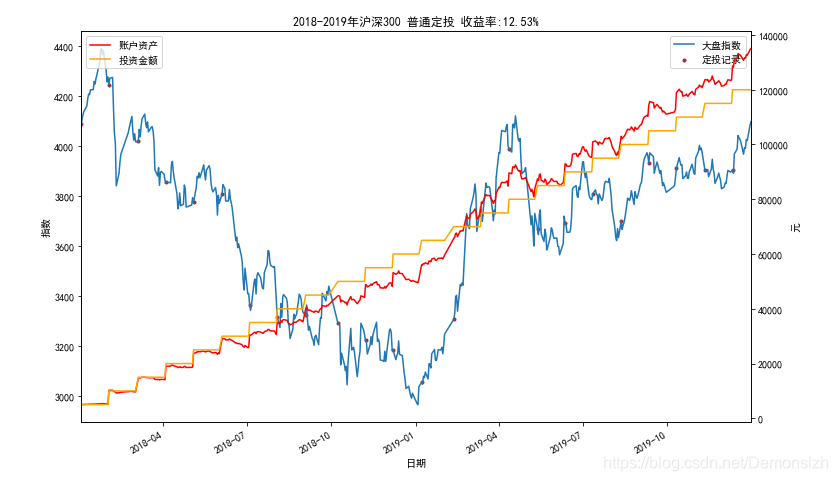文章目录
-
* 一、关于基金定投-
* 数据来源- 接口规范
- 常见指数基金/股票代码
- 二、分析目标
- 三、代码实现
-
* 1、定义获取数据、清洗数据的函数- 2、定义定投策略函数
- 3、计算2019年对沪深300指数基金进行定投的收益率
- 4、假设定投的金额是500元,每周定投一次,据此分别计算从2002年开始到2019年,每年定投沪深300指数基金的收益率并将结果可视化
- 5、实现"慧定投"(支付宝中的智能定投策略)
- 定义定投策略(对于每个交易日前一日的收盘价)
- 四、可视化普通定投与智能定投策略收益率
- 五、文末福利(完整代码)
-
基于Python的基金定投分析
通过获取过去10年的股市数据分析基金定投的收益率。
一、关于基金定投
基金定投,就是按照固定的频率和固定的金额,不停分批次小额买入金融市场上的基金。为什么要这么麻烦,这样做有什么好处吗?我们本次“数据分析和挖掘”的第四次作业就
指数基金定投 的效果来分析一下。
注:定投可以选择任何种类的基金。我们以指数基金为例,因为大部分传说中 无脑定投 的案例都是以指数基金的定投方式
数据来源
- 通过API接口从网易财经上进行调取
接口规范
其中
- code参数后面的7位整数代表了股票代码;比如0000001指的是上证指数。注意这串数字要分0和000001两部分看。0代表sh,1代表sz。所以0000001其实是sh000001的意思。同理,0 000300也就是sh000300 沪深300的代码。
- start和end参数后面的8位整数代表年(xxxx)月(xx)日(xx)
- fields选项中,TCLOSE,HIGH,LOW,TOPEN分别表示当日的收盘,最高,最低,开盘价;LCLOSE表示昨日收盘价。CHG,PCHG,VOTURNOVER,VAT分别表示涨跌额,涨跌幅,成交量,成交金额。
常见指数基金/股票代码
- 0000300 - 沪深300
- 0000001 - 上证指数
- 0000016 - 上证50
- 399005 - 中小板指
- 399673 - 创业板50
- 000903 - 中证100
二、分析目标
- 假设定投的金额是500元,每周定投一次,据此计算2019年对 沪深300指数 基金进行定投的收益率
- 假设定投的金额是500元,每周定投一次,据此 分别 计算从2002年开始到2019年,每年定投 沪深300指数基金 的收益率并将结果可视化
- 探索不同的定投策略。这里以支付宝的“慧定投”智能定投策略为例
注:不同的定投策略可以是改变定投周期(比如从每周定投到每月定投),改变定投金额(比如从固定金额到固定比例),设定止损或者止盈策略等等。
三、代码实现
1、定义获取数据、清洗数据的函数
import pandas as pd
import numpy as np
import matplotlib.pyplot as plt
import requests
import warnings
warnings.filterwarnings('ignore')
plt.rcParams['font.family']='SimHei'
plt.rcParams['axes.unicode_minus']=False
plt.rcParams['figure.figsize']=(12,8)
def get_data(code,start,end):
'''
获取指定时间范围的股票数据
:param code: 指数代码
:param start: 起始日期
:param end: 截止日期
:return: DataFrame
'''
url='http://quotes.money.163.com/service/chddata.html?code={}&start={}&end={}&fields=TCLOSE;HIGH;LOW;TOPEN;LCLOSE;CHG;PCHG;VOTURNOVER;VATURNOVER'.format(code,start,end)
name=code+'_'+start+"-"+end
f=open(name,'wb')
f.write(requests.get(url).content)
f.close()
data=pd.read_csv(name,encoding='gbk')
return data
def clean_data(data):
'''
1、将日期转换为时间序列并设置为索引
2、将数据按时间序列升序排序
3、删除缺失值
4、将涨跌幅的单位转换为小数
'''
data['日期']=pd.to_datetime(data['日期'])
data=data.set_index("日期")
data=data.sort_index()
data.drop(data[data["涨跌幅"]=="None"].index,axis=0,inplace=True)
data["涨跌幅"]=data['涨跌幅'].astype('float')
data['涨跌幅']/=100
return data
获取沪深300的数据,并查看
df1=get_data('0000300','20190102','20191231')
df1=clean_data(df1)

2、定义定投策略函数
def invest(df1,frequence,invest_money,start_time):
'''
定投计算
:param df1: 数据集
:param frequence: 定投频率
:param invest_money: 每次定投金额
:param start: 定投起始日期
:return (amount,invest_log): (收益数据DataFrame,定投记录dict)
'''
invest_log={}#每次定投的日期记录(日期:大盘指数)
invest_day=start_time#每次投资的时间
invest_amount=0#总投资金额
profile=0#总投资收益
amount=0#账户总资产
profile_log=[]#总收益日志
invest_amount_log=[]#账户投资金额日志
amount_log=[]#总资产日志
Yield=[]#收益率日志
for date,quote_change,index in zip(df1.index,df1['涨跌幅'],df1['收盘价']):
profile+=quote_change*amount#计算当天收益率
profile_log.append(profile)
#判断是否为定投日
if date==invest_day:
invest_amount+=invest_money
invest_log[invest_day]=index#记录定投当日的指数
#判断7天后是否为交易日,如果不是则往后加1天直到找到交易日
invest_day+=np.timedelta64(frequence,'D')
flag=0
while(True):
if(df1[df1.index==invest_day].index==invest_day):
break
else:
invest_day+=np.timedelta64(1,'D')
flag+=1
if(flag==100):
break
invest_amount_log.append(invest_amount)
amount=invest_amount+profile#更新账户总资产
amount_log.append(amount)
try:
Yield.append(profile/invest_amount*100)#更新收益率
except:
Yield.append(0)
print("总投资:",invest_amount)
print("总收益:",profile)
print("收益率: ",profile/invest_amount*100,"%")
over=pd.DataFrame({
"日期":df1.index,
"收益率":Yield,
"账户资产":amount_log,
"投资金额":invest_amount_log
})
over=over.set_index("日期")
return over,invest_log
3、计算2019年对沪深300指数基金进行定投的收益率
frequence=7#定投频率
invest_money=500#每次定投金额
start=np.datetime64("2019-01-02")
print("2019年定投结果显示:")
res,buy=invest(df1,frequence,invest_money,start)
def myplot(df1,res,buy,titlename):
'''
绘制定投结果图
'''
plt.figure()
df1['收盘价'].plot(label="大盘指数")
plt.scatter(buy.keys(),buy.values(),color="brown",marker=".",label="定投记录")
plt.legend(loc='best')
plt.ylabel("指数")
plt.twinx()
res['账户资产'].plot(color="red")
res['投资金额'].plot(color="orange")
plt.ylabel("元")
plt.legend()
plt.title(titlename+":{:.2f}%".format(res.tail(1)["收益率"][0]))
plt.show()
titlename="2019年沪深300定投收益率"
myplot(df1,res,buy,titlename)

4、假设定投的金额是500元,每周定投一次,据此分别计算从2002年开始到2019年,每年定投沪深300指数基金的收益率并将结果可视化
df2=get_data('0000300','20020101','20191231')
df2=clean_data(df2)
df2['收盘价'].plot()
plt.title("2002年-2019年沪深300指数")
frequence=7#定投频率
invest_money=500#每次定投金额
print("从2002年开始定投到2019年结束的收益情况:")
start=np.datetime64("2002-01-07")
res,buy=invest(df2,frequence,invest_money,start)
x=[str(i) for i in range(2002,2020)]
y=[]
for year in range(2002,2020):
'''每年的收益率:年末收益率-年初收益率'''
each_year=res[res.index.year==year].tail(1)["收益率"][0]-res[res.index.year==year].head(1)["收益率"][0]
y.append(each_year)
plt.title("2002年-2019年 沪深300 年定投收益率")
plt.ylabel("收益率(%)")
plt.xlabel("年")
plt.plot(x,y,label="年收益率")
plt.plot(x,[res.tail(1)["收益率"][0] for i in range(len(x))],ls="--",alpha=0.5,label="总投资收益率")
plt.plot(x,[0 for i in range(len(x))],color="gray",ls="--",alpha=0.3)
plt.xlim("2002","2019")
plt.legend()

5、实现"慧定投"(支付宝中的智能定投策略)
定义定投策略(对于每个交易日前一日的收盘价)
- 高于均线15%以内,扣款90%
- 高于均线15-50%,扣款80%
- 高于均线50-100% 扣款70%
- 高于均线 100%以上 扣款60%
-
近10日振幅小于5%
- 低于均线5%以内,扣款180%
- 低于均线5-10%以内,扣款190%
- 低于均线10-20%以内,扣款200%
- 低于均线20-30%以内,扣款210%
- 低于均线30-40%以内,扣款220%
- 低于均线40%以上,扣款230%
-
近10日振幅大于5%
- 低于均线5%以内,扣款60%
- 低于均线5-10%以内,扣款70%
- 低于均线10-20%以内,扣款80%
- 低于均线20-30%以内,扣款90%
- 低于均线30-40%以内,扣款100%
- 低于均线40%以上,扣款110%
所以在这个过程中我们需要定义几个函数,由于要考虑到均线与振幅的问题,所以首先需要定义均线、振幅函数,获取基金n日收益与m日振幅
def mean_days(df,days,wave):
'''
获取n日均线,最近m日振幅
:param df: 数据集
:param days: 均线天数
:params wave:最近m日振幅
:return average,wavelength:均线、近m日振幅
'''
average=[]
wavelength=[]
start=df.head(1).index-np.timedelta64(days+1,"D")
start=start.astype('str')[0].replace("-","")#转换为字符串
df4=get_data('0000300',start,'20191231')#获得原始数据前days天的数据用以求均值
df4=clean_data(df4)
for i in df3.index:
start_date=i-np.timedelta64(days+1,"D")
ave=df4[(df4.index>start_date) & (df4.index<i)]['收盘价'].mean()
average.append(ave)
########求振幅#######
start2=df.head(1).index-np.timedelta64(wave+1,"D")
start2=start2.astype('str')[0].replace("-","")#转换为字符串
df5=get_data('0000300',start2,'20191231')
df5=clean_data(df5)
for i in df3.index:
start_date=i-np.timedelta64(wave+1,"D")
interval=df5[(df5.index>start_date) & (df5.index<i)]['收盘价']
length=interval.max()/interval.min()-1#最大涨跌幅
wavelength.append(length)
return average,wavelength
智能定投策略计算收益率
def stratege(ml,wl,T_1):
'''
定投策略
:param ml:均线
:param wl:振幅
:param T_1:前1日收盘价
'''
cal=T_1/ml-1#大于0,则高于均线
if(cal>=0 and cal<0.15):
return 0.9
elif(cal>0.15 and cal<0.5):
return 0.8
elif(cal>=0.5 and cal<1):
return 0.7
elif(cal>=1):
return 0.6
elif(wl>0.05):
if(cal>=-0.05 and cal<0):
return 0.6
elif(cal>=-0.1 and cal<-0.05):
return 0.7
elif(cal>=-0.2 and cal<-0.1):
return 0.8
elif(cal>=-0.3 and cal<-0.2):
return 0.9
elif(cal>=-0.4 and cal<-0.3):
return 1.0
elif(cal<-0.4):
return 1.1
else:
if(cal>=-0.05 and cal<0):
return 1.8
elif(cal>=-0.1 and cal<-0.05):
return 1.9
elif(cal>=-0.2 and cal<-0.1):
return 2.0
elif(cal>=-0.3 and cal<-0.2):
return 2.1
elif(cal>=-0.4 and cal<-0.3):
return 2.2
elif(cal<-0.4):
return 2.3
完整策略实现
def smart_invest(df1,frequence,invest_money,start_time,days,wave):
'''
定投计算
:param df1: 数据集
:param frequence: 定投频率
:param invest_money: 每次定投金额
:param start: 定投起始日期
:param days: 参考均线天数
:return (amount,invest_log): (收益数据DataFrame,定投记录dict)
'''
invest_log={}#每次定投的日期记录(日期:大盘指数)
invest_day=start_time#每次投资的时间
invest_amount=0#总投资金额
profile=0#总投资收益
amount=0#账户总资产
profile_log=[]#总收益日志
invest_amount_log=[]#账户投资金额日志
amount_log=[]#总资产日志
Yield=[]#收益率日志
df1["均线"]=mean_days(df1,days,wave)[0]#获取均线
df1["振幅"]=mean_days(df1,days,wave)[1]#获取振幅
for date,quote_change,index,ml,wl in zip(df1.index,df1['涨跌幅'],df1['收盘价'],df1["均线"],df1["振幅"]):
profile+=quote_change*amount#计算当天收益率
profile_log.append(profile)
#判断是否为定投日
if date==invest_day:
if(invest_day==start_time):
T_1=start_time
else:
formal_day=1
while(True):
T_1=date-np.timedelta64(formal_day,"D")#前1天的收盘价
if(T_1 in df1.index.tolist()):
break
else:
formal_day+=1
T_1=df1[df1.index==T_1]["收盘价"][0]
rate=stratege(ml,wl,T_1)
invest_amount+=invest_money*rate#定投
invest_log[invest_day]=index#记录定投当日的指数
#判断7天后是否为交易日,如果不是则往后加1天直到找到交易日
invest_day+=np.timedelta64(frequence,'D')
flag=0
while(True):
if(df1[df1.index==invest_day].index==invest_day):
break
else:
invest_day+=np.timedelta64(1,'D')
flag+=1
if(flag==100):
break
invest_amount_log.append(invest_amount)
amount=invest_amount+profile#更新账户总资产
amount_log.append(amount)
try:
Yield.append(profile/invest_amount*100)#更新收益率
except:
Yield.append(0)
print("总投资:",invest_amount)
print("总收益:",profile)
print("收益率: ",profile/invest_amount*100,"%")
over=pd.DataFrame({
"日期":df1.index,
"收益率":Yield,
"账户资产":amount_log,
"投资金额":invest_amount_log
})
over=over.set_index("日期")
return over,invest_log
四、可视化普通定投与智能定投策略收益率
frequence=30#定投频率
invest_money=5000#每次定投金额
start=np.datetime64("2018-01-02")
print("优化后的定投策略(参考500日均线,近5日振幅的月定投):")
res1,buy1=smart_invest(df3,frequence,invest_money,start,500,5)
print("======================================\n普通定投策略:")
res2,buy2=invest(df3,frequence,invest_money,start)
myplot(df3,res1,buy1,"2018-2019年沪深300 优化定投 收益率")
myplot(df3,res2,buy2,"2018-2019年沪深300 普通定投 收益率")


五、文末福利(完整代码)
关注以下公众号回复"0003"获取完整源码









 浙公网安备 33010602011771号
浙公网安备 33010602011771号